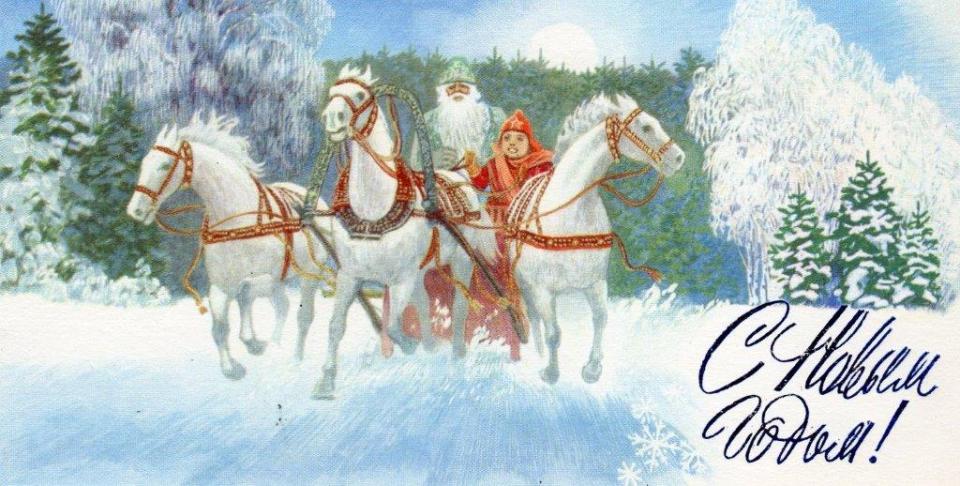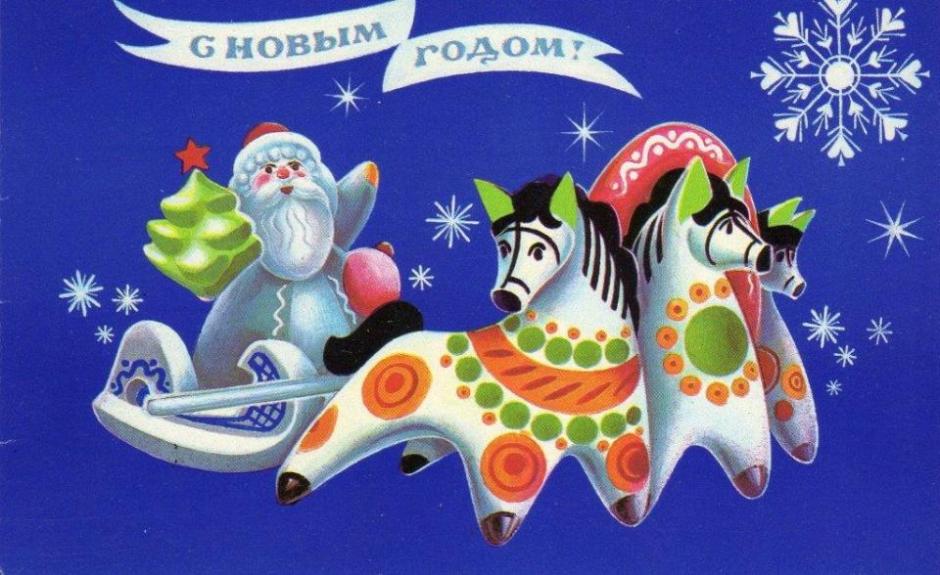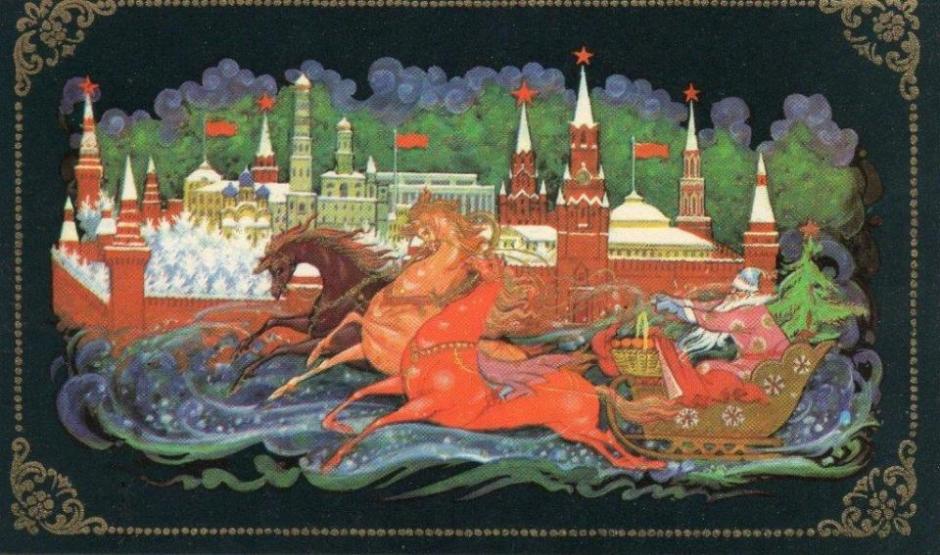December 20, 2015 - January 9, 2016: Issue 245
RUSSIAN NEW YEAR

RUSSIAN NEW YEAR
by George Repin
The principal feast day of the Russian calendar, for nearly one thousand years, has been Easter which continues to be celebrated throughout the world wherever adherents of the Russian Orthodox Church gather together. Although supressed during the Soviet era there has been an extraordinary resurgence of religious observance in Russia, particularly at Easter.
On the other hand New Year, not Christmas, is a major time of family celebrations. Families gather on New Year’s Eve shortly before midnight to eat and drink together and to mark the coming of the New Year with the greeting : с новым годом
(This is pronounced SNO-vim GO-dahm and is translated as Happy New Year, but literally it means With the New Year – a good wish for the year ahead).
A practice in traditional Russian families before the Russian Revolution, which has been maintained by some émigré families has been to bake a pirog – a rectangular pie made with minced cooked beef, onions, and hard-boiled eggs with a concealed gold (or silver) coin, and a bottom and top crust of yeast dough. At midnight the pie is marked out in rectangles which are dedicated to each member of the family, the “home” and, if the family has one or more businesses, to each of the businesses. The tradition is that the recipient of the piece with the coin will prosper in the New Year.
Although, historically, the start of the New Year in Russia was celebrated on different dates – such as at the Vernal Equinox, on March 1 and on September 1 – Peter the Great at the end of 1699 ordered that the celebration of the New Year would be on January 1 as was the case in many of the Protestant countries of Europe which followed the Julian calendar. He also ordered the use of fir trees, pine trees and juniper branches as decorations. However, when in the 18th Century the Protestant countries of Europe changed to the Gregorian calendar Russia maintained the Julian calendar and, accordingly, the dates of New Year’s day diverged until 1918 when the Gregorian calendar was adopted by the Soviets.
In 1929 the Soviets abolished Christmas and fir tree decorations and it was only at the end of 1935 that fir trees and New Year celebrations were restored. However it was not until 1949 that January 1 became an official holiday.
Decorated fir trees are in homes and Ded Moroz (Grandfather Frost) and his helper the fairy grand-daughter Snegourochka (“The Snow Maiden”) are associated with distributing presents to children in celebration of the New Year.
The Snow Maiden is also a character in a Russian Fairy Tale dating back to the early 19th Century unrelated to Ded Moroz.
While superficially similar Ded Moroz and Santa Claus are quite different characters. Ded Moroz wears a red caftan (an old style garment) edged with white fluff, a red (sometimes blue) Russian style fur trimmed cap (not a conical hat), white mittens and felt boots. He comes from deep in the Russian forests in a sleigh drawn by horses not by reindeers, and is not accompanied by gnomes. Unlike Santa Claus he has no relationship with Saint Nicholas.
Instead of Christmas cards Russians send New Year cards. Pictures of a selection of such cards which I received from the Medical Workers Union of the USSR in the late 1970s accompany this article.


Previous Reflections by George Repin
The Nineteen Thirties Remembering Rowe Street The Sydney Push Saturday Night at the Movies Shooting Through Like A Bondi Tram A Stop On The Road To Canberra City Department Stores - Gone and Mostly Forgotten An Australian Icon - thanks to Billy Hughes Crossing The Pacific in the 1930s Hill End The Paragon at Katoomba Seafood In Sydney How Far From Sydney? Cockatoo Island Over The Years The Seagull at the Melbourne Festival in 1991 Busby's Bore The Trocadero In Sydney Cahill's restaurants Medical Pioneers in Australian Wine Making Pedal Power and the Royal Flying Doctor Service Pambula and the Charles Darwin Connection Gloucester and the Barrington Tops A Millenium Apart Have You Stopped to Look? Gulgong Il Porcellino Olympia Durham Hall Sargent's Tea Rooms Pie Shops and Street Photographers The Ballet Russes and Their Friends in Australia Hotels at Bondi Alma Ata Conference - 1978 Keukenhof - 1954 The Lands Department Building and Yellowblock Sandstone The Goroka Show - 1958 A Gem On The Quay Staffa The Matson Line and Keepsake Menus Kokeshi Dolls The Coal Mine At Balmain The Hyde Park Barracks The Changing Faces Of Sydney From Pounds and Pence to Dollars and Cents Nell Tritton and Alexander Kerensky Making A Difference In Ethiopia William Balmain J C Bendrodt and Princes Restaurant Azzalin Orlando Romano and Romano's Restaurant Waldheim Alcohol in Restaurants Before 1955 King Island Kelp The Mercury Theatre Around Angkor - 1963 Angkor Wat 1963 Costumes From the Ballets Russe Clifton at Kirribilli Chairman Mao's Personal Physician The Toby Tavern The MoKa at Kings Cross The Oceaographic Museum in Monaco The Island of Elba Russian Fairy Tale Plates Meteora Souda Bay War Cemetery Barrow, Alaska Cloisonné Tripitaka Koreana Minshuku The Third Man Photographs and Memories Not A Chagall! Did You Listen? Did You Ask? Napier (Ahuriri, Maori) New Zealand Borobudur Ggantija Temples Plumes and Pearlshells Murano University of Padua Ancient Puebloe Peoples - The Anasazi Pula The Gondolas of Venice Cinque Terre Visiting the Iban David The Living Desert Bryce Canyon National Park Aphrodisias The Divine Comedy Caodaism Sapa and local Hill People A Few Children Cappadocia Symi Jean-Marie Tjibaou Cultural Centre Aboriginal Rock Art on Bigge Island ANZAC Cove (Ari Burnu) 25 April, 1997 Hotere Garden Oputae Children of the Trobriand Islands Page Park Market - Rabaul Rabual Kotor, Montenegro Galleries of Photographs I Lascaux Galleries of Photographs II The Cathedral of St. James – Šibenik, Croatia Ivan Meštrović - Sculptor Delphi Gallery of Photographs III The Handicrafts of Chiang Mai Raft Point San Simeon - "Hearst Castle" Floriade - The Netherlands - 1982
Copyright George Repin 2015. All Rights Reserved.